Management Accounting System and Techniques: Ryder Architecture
VerifiedAdded on 2023/06/18
|19
|5317
|458
Report
AI Summary
This report provides a comprehensive analysis of management accounting systems and techniques as applied to Ryder Architecture, a UK-based construction company, through the lens of Equilibrium Asset Management, a financial consultancy. It explores various types of managerial accounting systems, including inventory management, cost accounting, job costing, and price optimization, detailing their benefits and integration within business processes. The report also examines several methods for management accounting reporting, such as budget reports, accounts receivable aging reports, cost accounting reports, inventory management reports, and performance reports. Furthermore, it delves into different costing techniques like direct and indirect costs, cost analysis, cost-volume-profit analysis, flexible budgeting, cost variance analysis, marginal and absorption costing, and cost allocation. The study highlights the advantages and disadvantages of various planning tools and their application in budget preparation and forecasting, along with the role of management accounting systems in responding to financial problems and maintaining sustainable success. The report concludes by emphasizing the importance of integrating management accounting systems and managerial accounting reporting to improve business operations and efficiency.
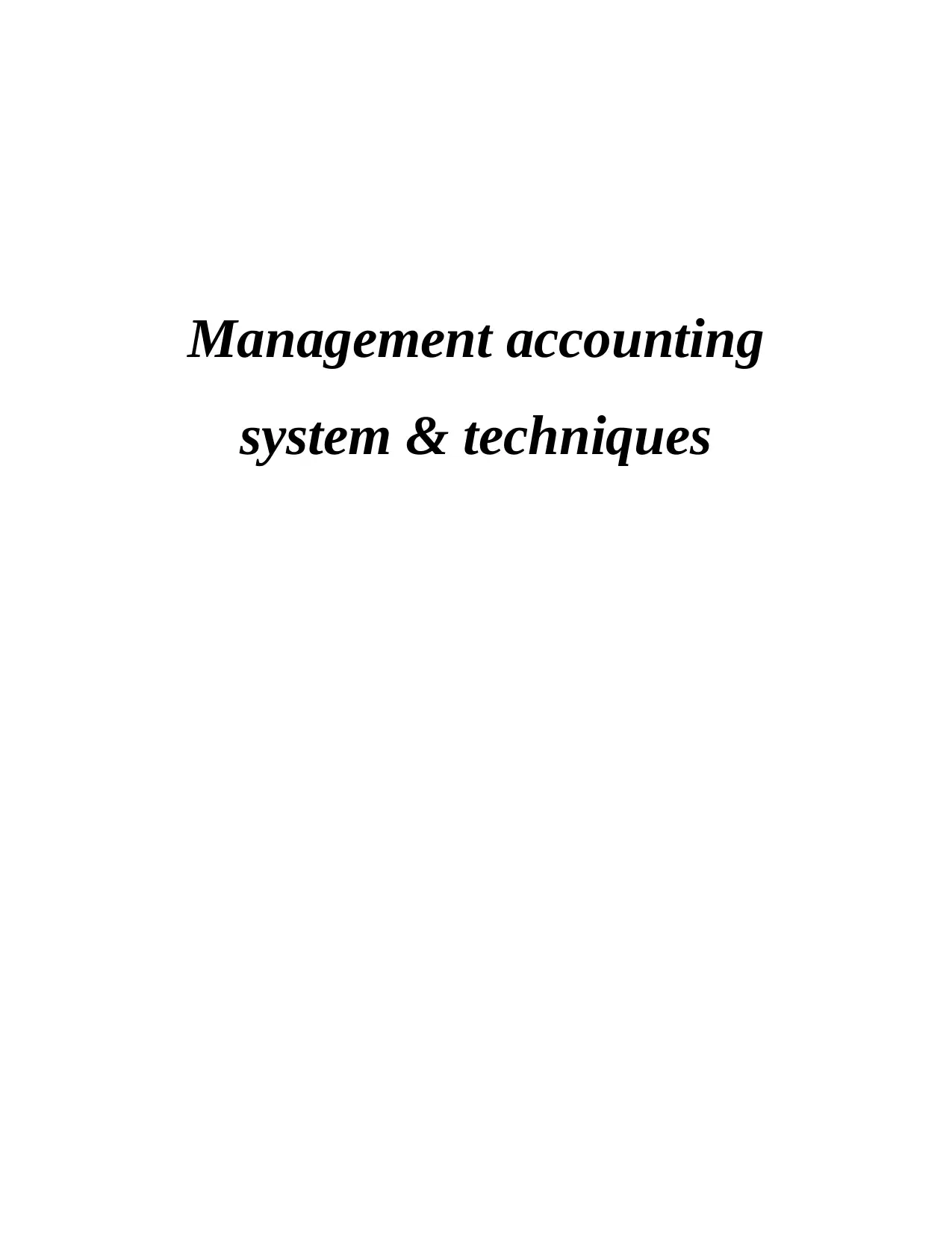
Management accounting
system & techniques
system & techniques
Paraphrase This Document
Need a fresh take? Get an instant paraphrase of this document with our AI Paraphraser
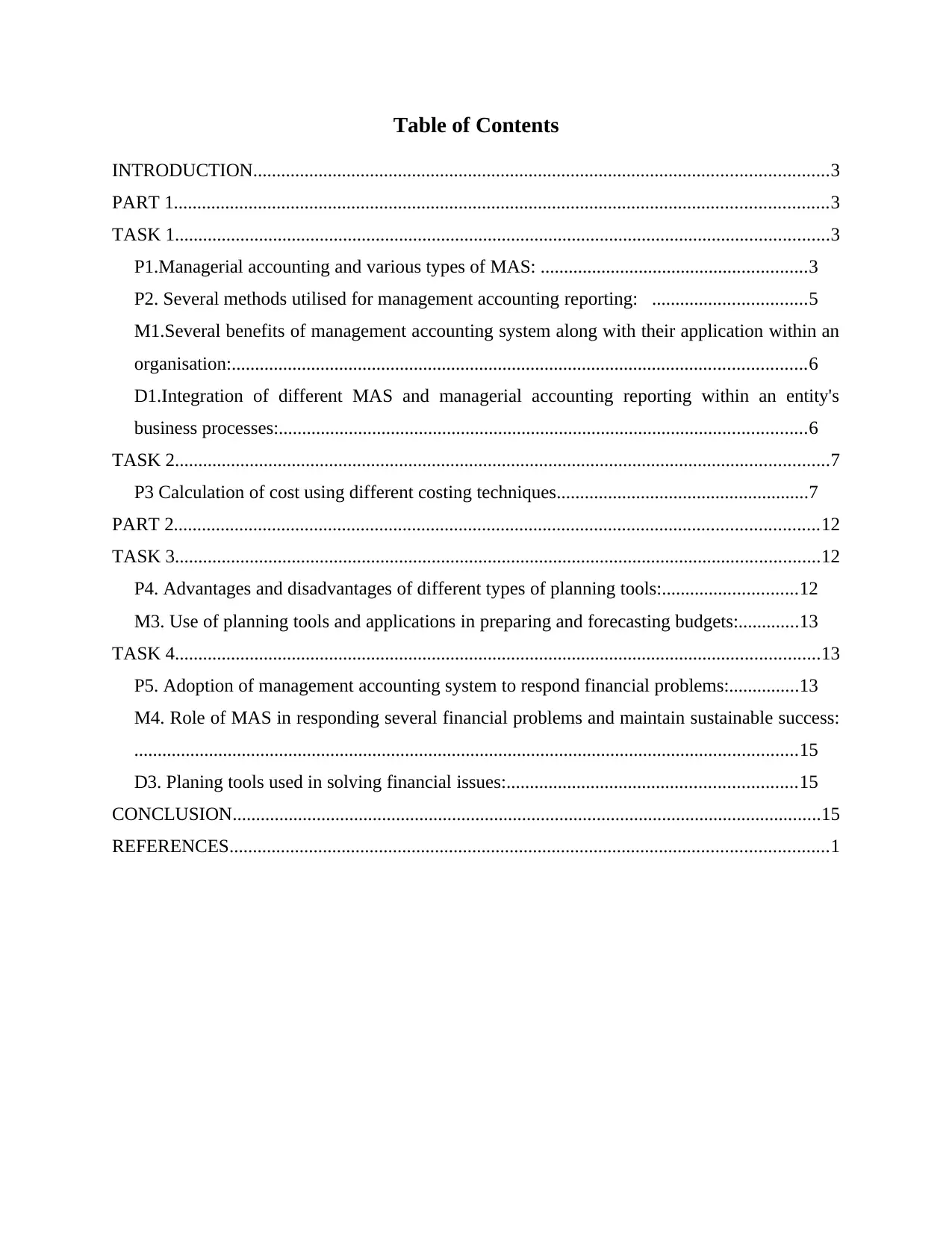
Table of Contents
INTRODUCTION...........................................................................................................................3
PART 1............................................................................................................................................3
TASK 1............................................................................................................................................3
P1.Managerial accounting and various types of MAS: .........................................................3
P2. Several methods utilised for management accounting reporting: .................................5
M1.Several benefits of management accounting system along with their application within an
organisation:...........................................................................................................................6
D1.Integration of different MAS and managerial accounting reporting within an entity's
business processes:.................................................................................................................6
TASK 2............................................................................................................................................7
P3 Calculation of cost using different costing techniques......................................................7
PART 2..........................................................................................................................................12
TASK 3..........................................................................................................................................12
P4. Advantages and disadvantages of different types of planning tools:.............................12
M3. Use of planning tools and applications in preparing and forecasting budgets:.............13
TASK 4..........................................................................................................................................13
P5. Adoption of management accounting system to respond financial problems:...............13
M4. Role of MAS in responding several financial problems and maintain sustainable success:
..............................................................................................................................................15
D3. Planing tools used in solving financial issues:..............................................................15
CONCLUSION..............................................................................................................................15
REFERENCES................................................................................................................................1
INTRODUCTION...........................................................................................................................3
PART 1............................................................................................................................................3
TASK 1............................................................................................................................................3
P1.Managerial accounting and various types of MAS: .........................................................3
P2. Several methods utilised for management accounting reporting: .................................5
M1.Several benefits of management accounting system along with their application within an
organisation:...........................................................................................................................6
D1.Integration of different MAS and managerial accounting reporting within an entity's
business processes:.................................................................................................................6
TASK 2............................................................................................................................................7
P3 Calculation of cost using different costing techniques......................................................7
PART 2..........................................................................................................................................12
TASK 3..........................................................................................................................................12
P4. Advantages and disadvantages of different types of planning tools:.............................12
M3. Use of planning tools and applications in preparing and forecasting budgets:.............13
TASK 4..........................................................................................................................................13
P5. Adoption of management accounting system to respond financial problems:...............13
M4. Role of MAS in responding several financial problems and maintain sustainable success:
..............................................................................................................................................15
D3. Planing tools used in solving financial issues:..............................................................15
CONCLUSION..............................................................................................................................15
REFERENCES................................................................................................................................1

⊘ This is a preview!⊘
Do you want full access?
Subscribe today to unlock all pages.

Trusted by 1+ million students worldwide
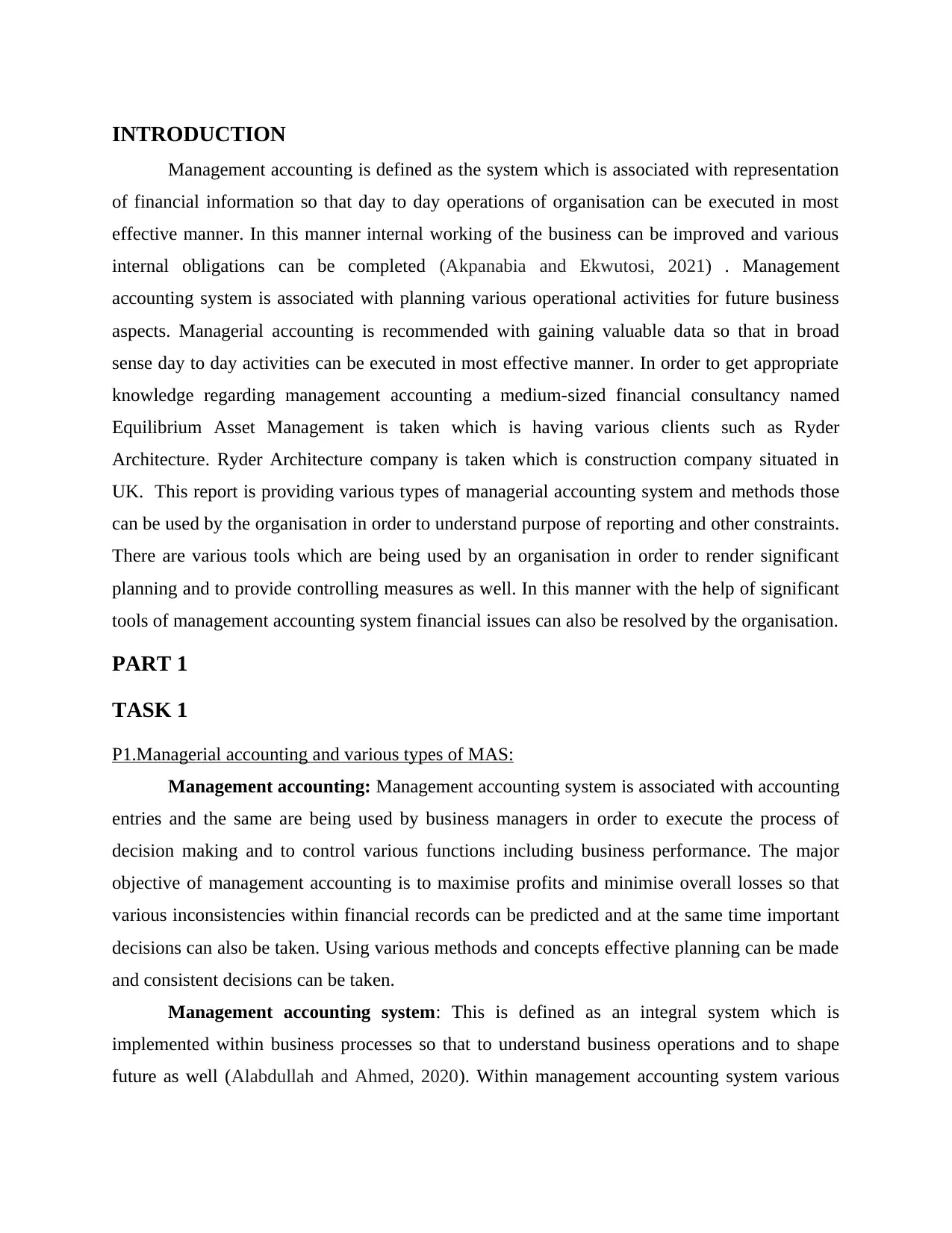
INTRODUCTION
Management accounting is defined as the system which is associated with representation
of financial information so that day to day operations of organisation can be executed in most
effective manner. In this manner internal working of the business can be improved and various
internal obligations can be completed (Akpanabia and Ekwutosi, 2021) . Management
accounting system is associated with planning various operational activities for future business
aspects. Managerial accounting is recommended with gaining valuable data so that in broad
sense day to day activities can be executed in most effective manner. In order to get appropriate
knowledge regarding management accounting a medium-sized financial consultancy named
Equilibrium Asset Management is taken which is having various clients such as Ryder
Architecture. Ryder Architecture company is taken which is construction company situated in
UK. This report is providing various types of managerial accounting system and methods those
can be used by the organisation in order to understand purpose of reporting and other constraints.
There are various tools which are being used by an organisation in order to render significant
planning and to provide controlling measures as well. In this manner with the help of significant
tools of management accounting system financial issues can also be resolved by the organisation.
PART 1
TASK 1
P1.Managerial accounting and various types of MAS:
Management accounting: Management accounting system is associated with accounting
entries and the same are being used by business managers in order to execute the process of
decision making and to control various functions including business performance. The major
objective of management accounting is to maximise profits and minimise overall losses so that
various inconsistencies within financial records can be predicted and at the same time important
decisions can also be taken. Using various methods and concepts effective planning can be made
and consistent decisions can be taken.
Management accounting system: This is defined as an integral system which is
implemented within business processes so that to understand business operations and to shape
future as well (Alabdullah and Ahmed, 2020). Within management accounting system various
Management accounting is defined as the system which is associated with representation
of financial information so that day to day operations of organisation can be executed in most
effective manner. In this manner internal working of the business can be improved and various
internal obligations can be completed (Akpanabia and Ekwutosi, 2021) . Management
accounting system is associated with planning various operational activities for future business
aspects. Managerial accounting is recommended with gaining valuable data so that in broad
sense day to day activities can be executed in most effective manner. In order to get appropriate
knowledge regarding management accounting a medium-sized financial consultancy named
Equilibrium Asset Management is taken which is having various clients such as Ryder
Architecture. Ryder Architecture company is taken which is construction company situated in
UK. This report is providing various types of managerial accounting system and methods those
can be used by the organisation in order to understand purpose of reporting and other constraints.
There are various tools which are being used by an organisation in order to render significant
planning and to provide controlling measures as well. In this manner with the help of significant
tools of management accounting system financial issues can also be resolved by the organisation.
PART 1
TASK 1
P1.Managerial accounting and various types of MAS:
Management accounting: Management accounting system is associated with accounting
entries and the same are being used by business managers in order to execute the process of
decision making and to control various functions including business performance. The major
objective of management accounting is to maximise profits and minimise overall losses so that
various inconsistencies within financial records can be predicted and at the same time important
decisions can also be taken. Using various methods and concepts effective planning can be made
and consistent decisions can be taken.
Management accounting system: This is defined as an integral system which is
implemented within business processes so that to understand business operations and to shape
future as well (Alabdullah and Ahmed, 2020). Within management accounting system various
Paraphrase This Document
Need a fresh take? Get an instant paraphrase of this document with our AI Paraphraser
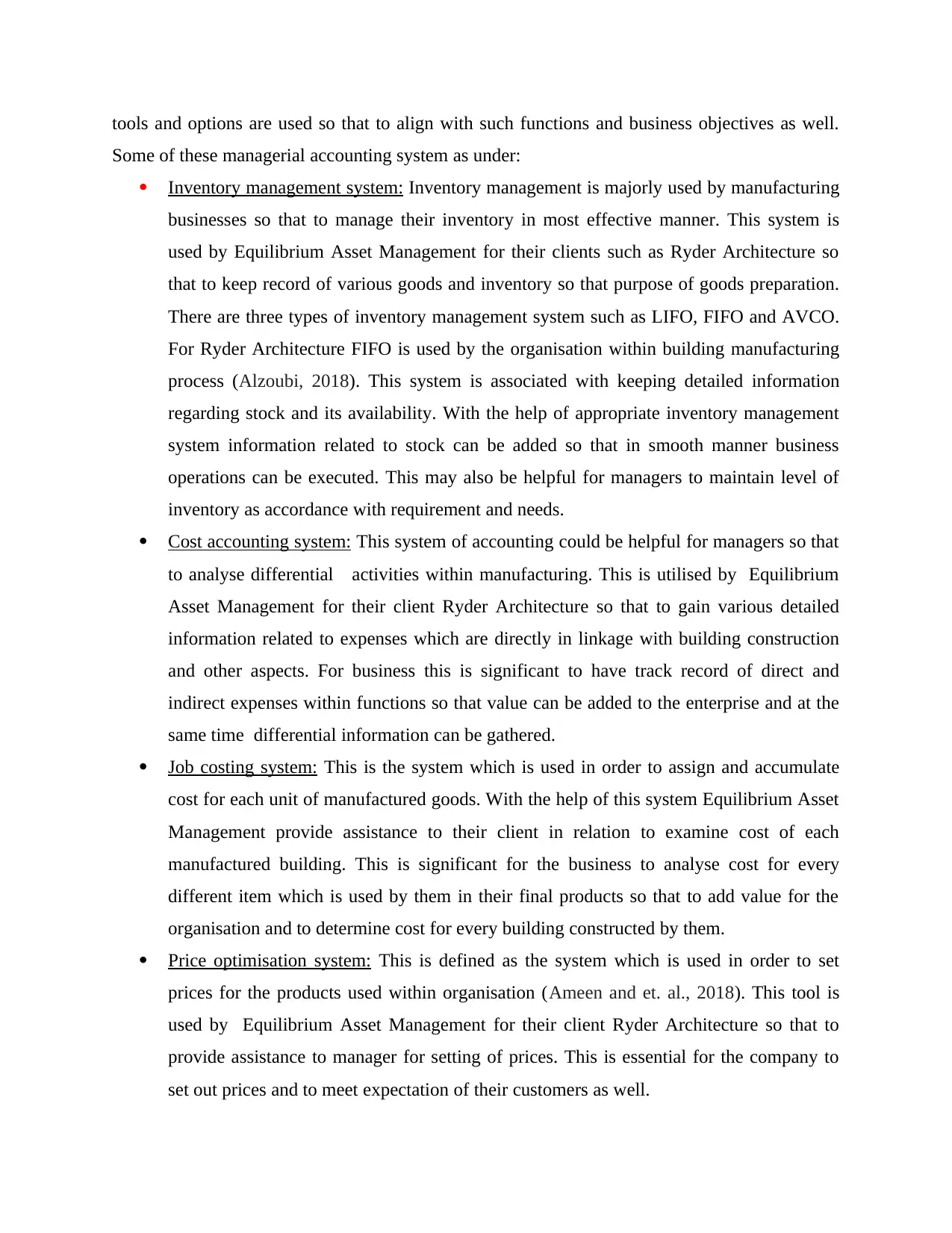
tools and options are used so that to align with such functions and business objectives as well.
Some of these managerial accounting system as under:
Inventory management system: Inventory management is majorly used by manufacturing
businesses so that to manage their inventory in most effective manner. This system is
used by Equilibrium Asset Management for their clients such as Ryder Architecture so
that to keep record of various goods and inventory so that purpose of goods preparation.
There are three types of inventory management system such as LIFO, FIFO and AVCO.
For Ryder Architecture FIFO is used by the organisation within building manufacturing
process (Alzoubi, 2018). This system is associated with keeping detailed information
regarding stock and its availability. With the help of appropriate inventory management
system information related to stock can be added so that in smooth manner business
operations can be executed. This may also be helpful for managers to maintain level of
inventory as accordance with requirement and needs.
Cost accounting system: This system of accounting could be helpful for managers so that
to analyse differential activities within manufacturing. This is utilised by Equilibrium
Asset Management for their client Ryder Architecture so that to gain various detailed
information related to expenses which are directly in linkage with building construction
and other aspects. For business this is significant to have track record of direct and
indirect expenses within functions so that value can be added to the enterprise and at the
same time differential information can be gathered.
Job costing system: This is the system which is used in order to assign and accumulate
cost for each unit of manufactured goods. With the help of this system Equilibrium Asset
Management provide assistance to their client in relation to examine cost of each
manufactured building. This is significant for the business to analyse cost for every
different item which is used by them in their final products so that to add value for the
organisation and to determine cost for every building constructed by them.
Price optimisation system: This is defined as the system which is used in order to set
prices for the products used within organisation (Ameen and et. al., 2018). This tool is
used by Equilibrium Asset Management for their client Ryder Architecture so that to
provide assistance to manager for setting of prices. This is essential for the company to
set out prices and to meet expectation of their customers as well.
Some of these managerial accounting system as under:
Inventory management system: Inventory management is majorly used by manufacturing
businesses so that to manage their inventory in most effective manner. This system is
used by Equilibrium Asset Management for their clients such as Ryder Architecture so
that to keep record of various goods and inventory so that purpose of goods preparation.
There are three types of inventory management system such as LIFO, FIFO and AVCO.
For Ryder Architecture FIFO is used by the organisation within building manufacturing
process (Alzoubi, 2018). This system is associated with keeping detailed information
regarding stock and its availability. With the help of appropriate inventory management
system information related to stock can be added so that in smooth manner business
operations can be executed. This may also be helpful for managers to maintain level of
inventory as accordance with requirement and needs.
Cost accounting system: This system of accounting could be helpful for managers so that
to analyse differential activities within manufacturing. This is utilised by Equilibrium
Asset Management for their client Ryder Architecture so that to gain various detailed
information related to expenses which are directly in linkage with building construction
and other aspects. For business this is significant to have track record of direct and
indirect expenses within functions so that value can be added to the enterprise and at the
same time differential information can be gathered.
Job costing system: This is the system which is used in order to assign and accumulate
cost for each unit of manufactured goods. With the help of this system Equilibrium Asset
Management provide assistance to their client in relation to examine cost of each
manufactured building. This is significant for the business to analyse cost for every
different item which is used by them in their final products so that to add value for the
organisation and to determine cost for every building constructed by them.
Price optimisation system: This is defined as the system which is used in order to set
prices for the products used within organisation (Ameen and et. al., 2018). This tool is
used by Equilibrium Asset Management for their client Ryder Architecture so that to
provide assistance to manager for setting of prices. This is essential for the company to
set out prices and to meet expectation of their customers as well.
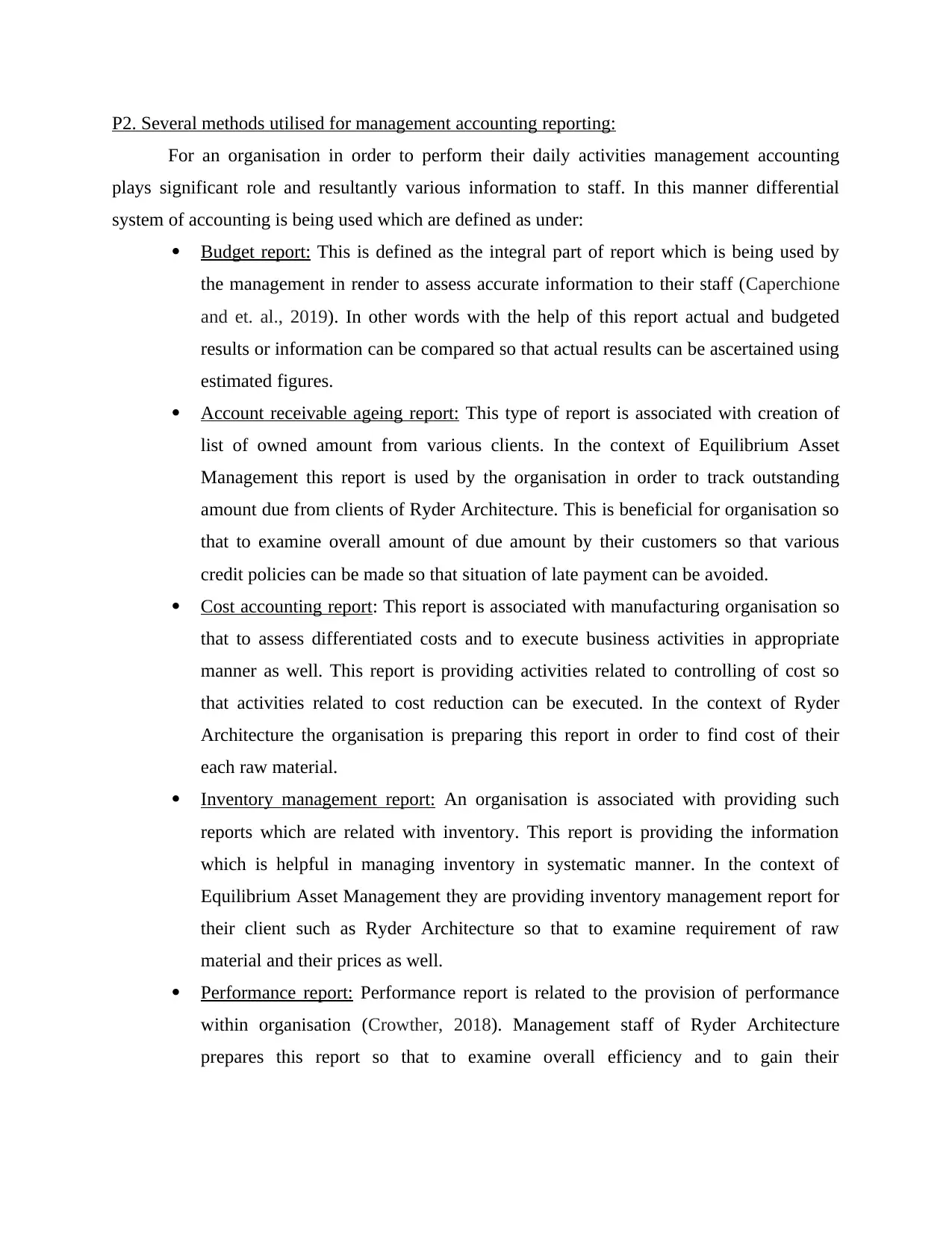
P2. Several methods utilised for management accounting reporting:
For an organisation in order to perform their daily activities management accounting
plays significant role and resultantly various information to staff. In this manner differential
system of accounting is being used which are defined as under:
Budget report: This is defined as the integral part of report which is being used by
the management in render to assess accurate information to their staff (Caperchione
and et. al., 2019). In other words with the help of this report actual and budgeted
results or information can be compared so that actual results can be ascertained using
estimated figures.
Account receivable ageing report: This type of report is associated with creation of
list of owned amount from various clients. In the context of Equilibrium Asset
Management this report is used by the organisation in order to track outstanding
amount due from clients of Ryder Architecture. This is beneficial for organisation so
that to examine overall amount of due amount by their customers so that various
credit policies can be made so that situation of late payment can be avoided.
Cost accounting report: This report is associated with manufacturing organisation so
that to assess differentiated costs and to execute business activities in appropriate
manner as well. This report is providing activities related to controlling of cost so
that activities related to cost reduction can be executed. In the context of Ryder
Architecture the organisation is preparing this report in order to find cost of their
each raw material.
Inventory management report: An organisation is associated with providing such
reports which are related with inventory. This report is providing the information
which is helpful in managing inventory in systematic manner. In the context of
Equilibrium Asset Management they are providing inventory management report for
their client such as Ryder Architecture so that to examine requirement of raw
material and their prices as well.
Performance report: Performance report is related to the provision of performance
within organisation (Crowther, 2018). Management staff of Ryder Architecture
prepares this report so that to examine overall efficiency and to gain their
For an organisation in order to perform their daily activities management accounting
plays significant role and resultantly various information to staff. In this manner differential
system of accounting is being used which are defined as under:
Budget report: This is defined as the integral part of report which is being used by
the management in render to assess accurate information to their staff (Caperchione
and et. al., 2019). In other words with the help of this report actual and budgeted
results or information can be compared so that actual results can be ascertained using
estimated figures.
Account receivable ageing report: This type of report is associated with creation of
list of owned amount from various clients. In the context of Equilibrium Asset
Management this report is used by the organisation in order to track outstanding
amount due from clients of Ryder Architecture. This is beneficial for organisation so
that to examine overall amount of due amount by their customers so that various
credit policies can be made so that situation of late payment can be avoided.
Cost accounting report: This report is associated with manufacturing organisation so
that to assess differentiated costs and to execute business activities in appropriate
manner as well. This report is providing activities related to controlling of cost so
that activities related to cost reduction can be executed. In the context of Ryder
Architecture the organisation is preparing this report in order to find cost of their
each raw material.
Inventory management report: An organisation is associated with providing such
reports which are related with inventory. This report is providing the information
which is helpful in managing inventory in systematic manner. In the context of
Equilibrium Asset Management they are providing inventory management report for
their client such as Ryder Architecture so that to examine requirement of raw
material and their prices as well.
Performance report: Performance report is related to the provision of performance
within organisation (Crowther, 2018). Management staff of Ryder Architecture
prepares this report so that to examine overall efficiency and to gain their
⊘ This is a preview!⊘
Do you want full access?
Subscribe today to unlock all pages.

Trusted by 1+ million students worldwide
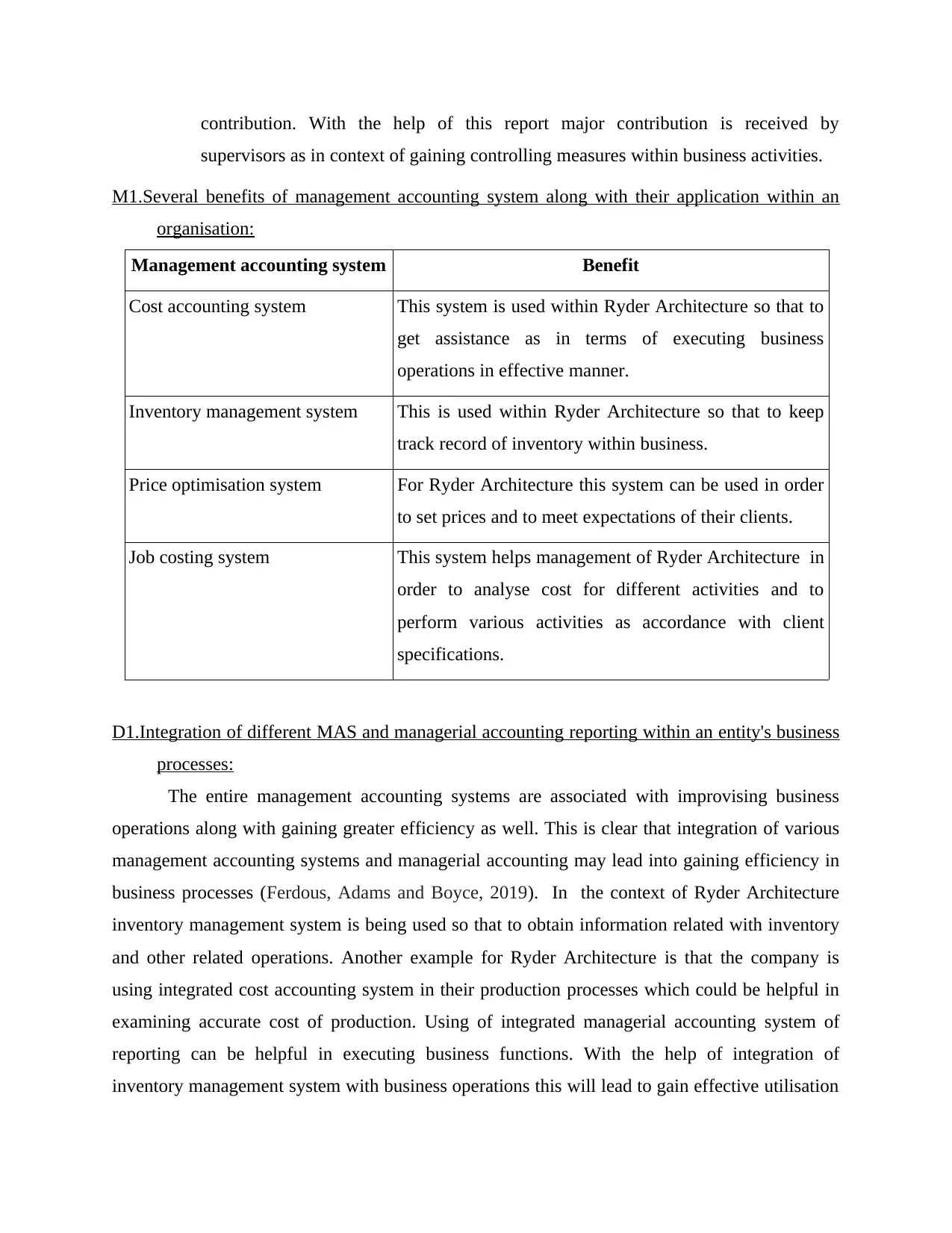
contribution. With the help of this report major contribution is received by
supervisors as in context of gaining controlling measures within business activities.
M1.Several benefits of management accounting system along with their application within an
organisation:
Management accounting system Benefit
Cost accounting system This system is used within Ryder Architecture so that to
get assistance as in terms of executing business
operations in effective manner.
Inventory management system This is used within Ryder Architecture so that to keep
track record of inventory within business.
Price optimisation system For Ryder Architecture this system can be used in order
to set prices and to meet expectations of their clients.
Job costing system This system helps management of Ryder Architecture in
order to analyse cost for different activities and to
perform various activities as accordance with client
specifications.
D1.Integration of different MAS and managerial accounting reporting within an entity's business
processes:
The entire management accounting systems are associated with improvising business
operations along with gaining greater efficiency as well. This is clear that integration of various
management accounting systems and managerial accounting may lead into gaining efficiency in
business processes (Ferdous, Adams and Boyce, 2019). In the context of Ryder Architecture
inventory management system is being used so that to obtain information related with inventory
and other related operations. Another example for Ryder Architecture is that the company is
using integrated cost accounting system in their production processes which could be helpful in
examining accurate cost of production. Using of integrated managerial accounting system of
reporting can be helpful in executing business functions. With the help of integration of
inventory management system with business operations this will lead to gain effective utilisation
supervisors as in context of gaining controlling measures within business activities.
M1.Several benefits of management accounting system along with their application within an
organisation:
Management accounting system Benefit
Cost accounting system This system is used within Ryder Architecture so that to
get assistance as in terms of executing business
operations in effective manner.
Inventory management system This is used within Ryder Architecture so that to keep
track record of inventory within business.
Price optimisation system For Ryder Architecture this system can be used in order
to set prices and to meet expectations of their clients.
Job costing system This system helps management of Ryder Architecture in
order to analyse cost for different activities and to
perform various activities as accordance with client
specifications.
D1.Integration of different MAS and managerial accounting reporting within an entity's business
processes:
The entire management accounting systems are associated with improvising business
operations along with gaining greater efficiency as well. This is clear that integration of various
management accounting systems and managerial accounting may lead into gaining efficiency in
business processes (Ferdous, Adams and Boyce, 2019). In the context of Ryder Architecture
inventory management system is being used so that to obtain information related with inventory
and other related operations. Another example for Ryder Architecture is that the company is
using integrated cost accounting system in their production processes which could be helpful in
examining accurate cost of production. Using of integrated managerial accounting system of
reporting can be helpful in executing business functions. With the help of integration of
inventory management system with business operations this will lead to gain effective utilisation
Paraphrase This Document
Need a fresh take? Get an instant paraphrase of this document with our AI Paraphraser
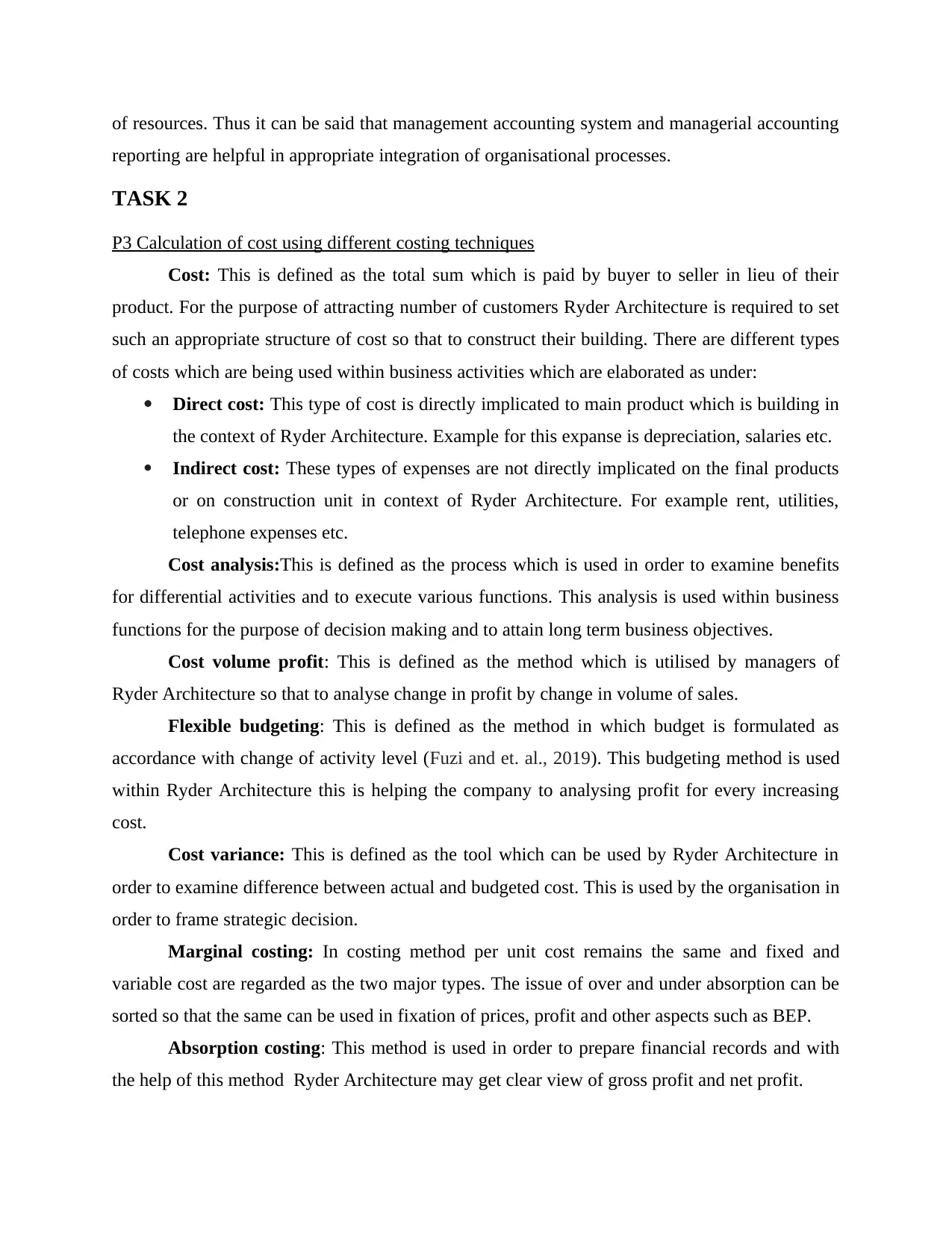
of resources. Thus it can be said that management accounting system and managerial accounting
reporting are helpful in appropriate integration of organisational processes.
TASK 2
P3 Calculation of cost using different costing techniques
Cost: This is defined as the total sum which is paid by buyer to seller in lieu of their
product. For the purpose of attracting number of customers Ryder Architecture is required to set
such an appropriate structure of cost so that to construct their building. There are different types
of costs which are being used within business activities which are elaborated as under:
Direct cost: This type of cost is directly implicated to main product which is building in
the context of Ryder Architecture. Example for this expanse is depreciation, salaries etc.
Indirect cost: These types of expenses are not directly implicated on the final products
or on construction unit in context of Ryder Architecture. For example rent, utilities,
telephone expenses etc.
Cost analysis:This is defined as the process which is used in order to examine benefits
for differential activities and to execute various functions. This analysis is used within business
functions for the purpose of decision making and to attain long term business objectives.
Cost volume profit: This is defined as the method which is utilised by managers of
Ryder Architecture so that to analyse change in profit by change in volume of sales.
Flexible budgeting: This is defined as the method in which budget is formulated as
accordance with change of activity level (Fuzi and et. al., 2019). This budgeting method is used
within Ryder Architecture this is helping the company to analysing profit for every increasing
cost.
Cost variance: This is defined as the tool which can be used by Ryder Architecture in
order to examine difference between actual and budgeted cost. This is used by the organisation in
order to frame strategic decision.
Marginal costing: In costing method per unit cost remains the same and fixed and
variable cost are regarded as the two major types. The issue of over and under absorption can be
sorted so that the same can be used in fixation of prices, profit and other aspects such as BEP.
Absorption costing: This method is used in order to prepare financial records and with
the help of this method Ryder Architecture may get clear view of gross profit and net profit.
reporting are helpful in appropriate integration of organisational processes.
TASK 2
P3 Calculation of cost using different costing techniques
Cost: This is defined as the total sum which is paid by buyer to seller in lieu of their
product. For the purpose of attracting number of customers Ryder Architecture is required to set
such an appropriate structure of cost so that to construct their building. There are different types
of costs which are being used within business activities which are elaborated as under:
Direct cost: This type of cost is directly implicated to main product which is building in
the context of Ryder Architecture. Example for this expanse is depreciation, salaries etc.
Indirect cost: These types of expenses are not directly implicated on the final products
or on construction unit in context of Ryder Architecture. For example rent, utilities,
telephone expenses etc.
Cost analysis:This is defined as the process which is used in order to examine benefits
for differential activities and to execute various functions. This analysis is used within business
functions for the purpose of decision making and to attain long term business objectives.
Cost volume profit: This is defined as the method which is utilised by managers of
Ryder Architecture so that to analyse change in profit by change in volume of sales.
Flexible budgeting: This is defined as the method in which budget is formulated as
accordance with change of activity level (Fuzi and et. al., 2019). This budgeting method is used
within Ryder Architecture this is helping the company to analysing profit for every increasing
cost.
Cost variance: This is defined as the tool which can be used by Ryder Architecture in
order to examine difference between actual and budgeted cost. This is used by the organisation in
order to frame strategic decision.
Marginal costing: In costing method per unit cost remains the same and fixed and
variable cost are regarded as the two major types. The issue of over and under absorption can be
sorted so that the same can be used in fixation of prices, profit and other aspects such as BEP.
Absorption costing: This method is used in order to prepare financial records and with
the help of this method Ryder Architecture may get clear view of gross profit and net profit.
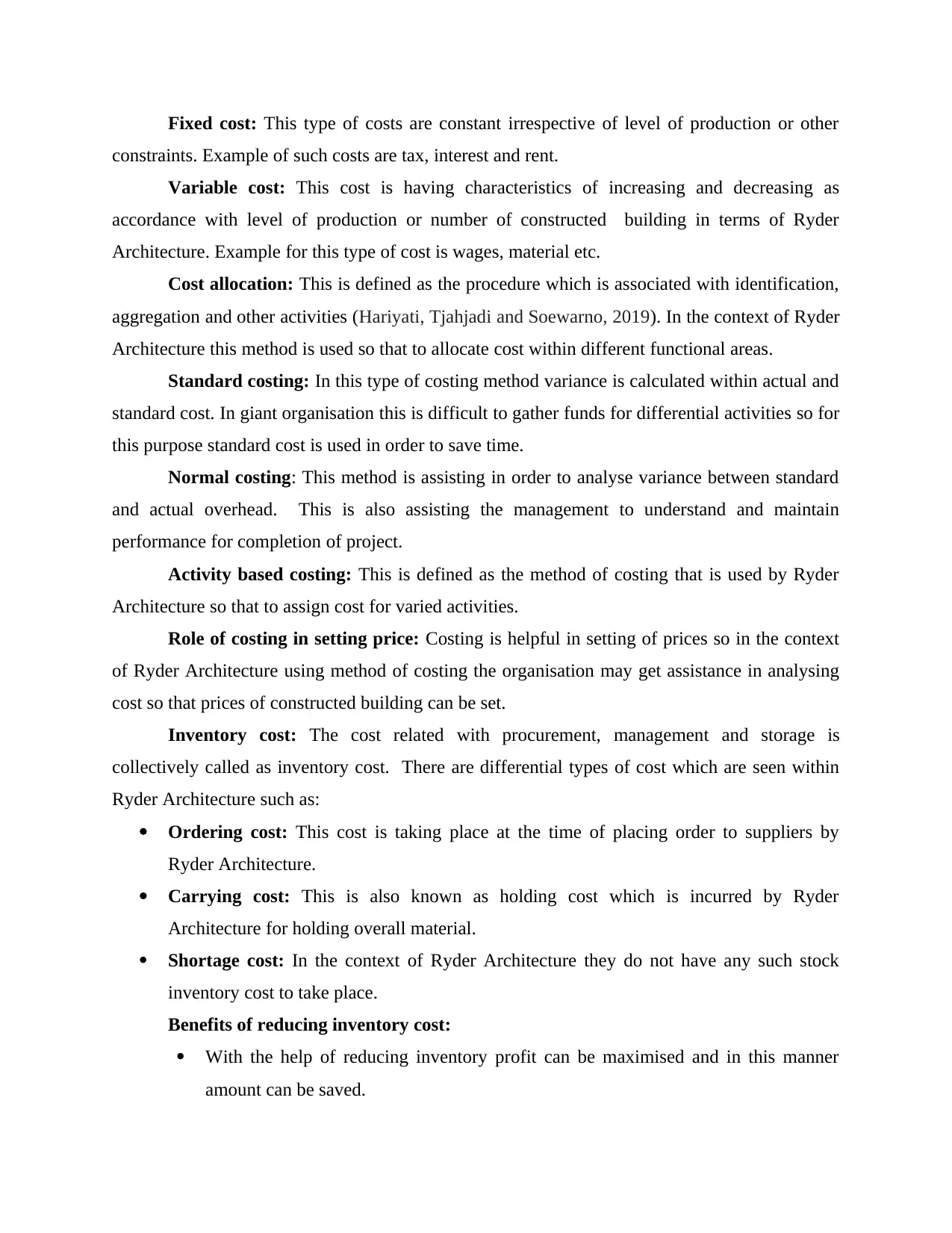
Fixed cost: This type of costs are constant irrespective of level of production or other
constraints. Example of such costs are tax, interest and rent.
Variable cost: This cost is having characteristics of increasing and decreasing as
accordance with level of production or number of constructed building in terms of Ryder
Architecture. Example for this type of cost is wages, material etc.
Cost allocation: This is defined as the procedure which is associated with identification,
aggregation and other activities (Hariyati, Tjahjadi and Soewarno, 2019). In the context of Ryder
Architecture this method is used so that to allocate cost within different functional areas.
Standard costing: In this type of costing method variance is calculated within actual and
standard cost. In giant organisation this is difficult to gather funds for differential activities so for
this purpose standard cost is used in order to save time.
Normal costing: This method is assisting in order to analyse variance between standard
and actual overhead. This is also assisting the management to understand and maintain
performance for completion of project.
Activity based costing: This is defined as the method of costing that is used by Ryder
Architecture so that to assign cost for varied activities.
Role of costing in setting price: Costing is helpful in setting of prices so in the context
of Ryder Architecture using method of costing the organisation may get assistance in analysing
cost so that prices of constructed building can be set.
Inventory cost: The cost related with procurement, management and storage is
collectively called as inventory cost. There are differential types of cost which are seen within
Ryder Architecture such as:
Ordering cost: This cost is taking place at the time of placing order to suppliers by
Ryder Architecture.
Carrying cost: This is also known as holding cost which is incurred by Ryder
Architecture for holding overall material.
Shortage cost: In the context of Ryder Architecture they do not have any such stock
inventory cost to take place.
Benefits of reducing inventory cost:
With the help of reducing inventory profit can be maximised and in this manner
amount can be saved.
constraints. Example of such costs are tax, interest and rent.
Variable cost: This cost is having characteristics of increasing and decreasing as
accordance with level of production or number of constructed building in terms of Ryder
Architecture. Example for this type of cost is wages, material etc.
Cost allocation: This is defined as the procedure which is associated with identification,
aggregation and other activities (Hariyati, Tjahjadi and Soewarno, 2019). In the context of Ryder
Architecture this method is used so that to allocate cost within different functional areas.
Standard costing: In this type of costing method variance is calculated within actual and
standard cost. In giant organisation this is difficult to gather funds for differential activities so for
this purpose standard cost is used in order to save time.
Normal costing: This method is assisting in order to analyse variance between standard
and actual overhead. This is also assisting the management to understand and maintain
performance for completion of project.
Activity based costing: This is defined as the method of costing that is used by Ryder
Architecture so that to assign cost for varied activities.
Role of costing in setting price: Costing is helpful in setting of prices so in the context
of Ryder Architecture using method of costing the organisation may get assistance in analysing
cost so that prices of constructed building can be set.
Inventory cost: The cost related with procurement, management and storage is
collectively called as inventory cost. There are differential types of cost which are seen within
Ryder Architecture such as:
Ordering cost: This cost is taking place at the time of placing order to suppliers by
Ryder Architecture.
Carrying cost: This is also known as holding cost which is incurred by Ryder
Architecture for holding overall material.
Shortage cost: In the context of Ryder Architecture they do not have any such stock
inventory cost to take place.
Benefits of reducing inventory cost:
With the help of reducing inventory profit can be maximised and in this manner
amount can be saved.
⊘ This is a preview!⊘
Do you want full access?
Subscribe today to unlock all pages.

Trusted by 1+ million students worldwide
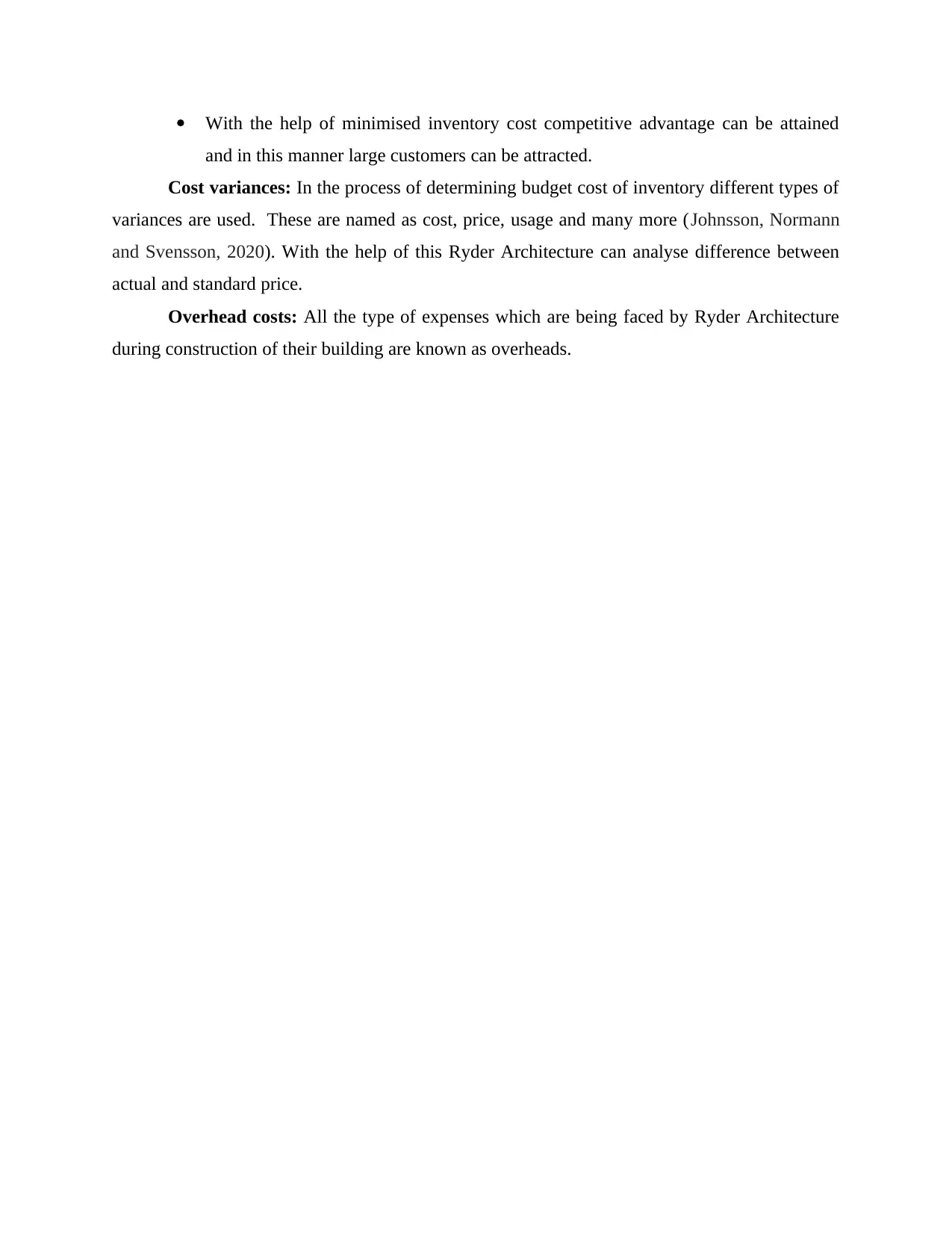
With the help of minimised inventory cost competitive advantage can be attained
and in this manner large customers can be attracted.
Cost variances: In the process of determining budget cost of inventory different types of
variances are used. These are named as cost, price, usage and many more (Johnsson, Normann
and Svensson, 2020). With the help of this Ryder Architecture can analyse difference between
actual and standard price.
Overhead costs: All the type of expenses which are being faced by Ryder Architecture
during construction of their building are known as overheads.
and in this manner large customers can be attracted.
Cost variances: In the process of determining budget cost of inventory different types of
variances are used. These are named as cost, price, usage and many more (Johnsson, Normann
and Svensson, 2020). With the help of this Ryder Architecture can analyse difference between
actual and standard price.
Overhead costs: All the type of expenses which are being faced by Ryder Architecture
during construction of their building are known as overheads.
Paraphrase This Document
Need a fresh take? Get an instant paraphrase of this document with our AI Paraphraser
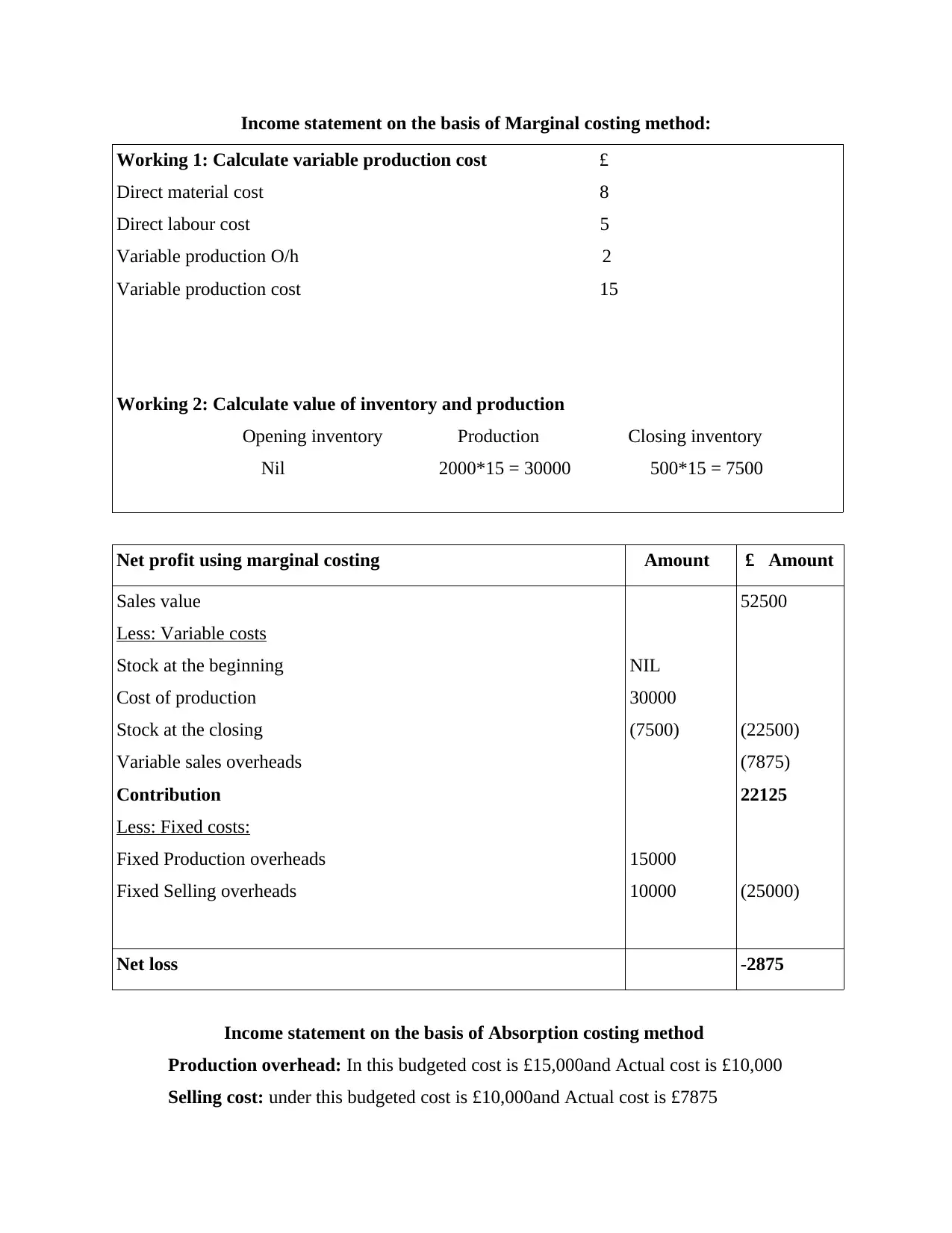
Income statement on the basis of Marginal costing method:
Working 1: Calculate variable production cost £
Direct material cost 8
Direct labour cost 5
Variable production O/h 2
Variable production cost 15
Working 2: Calculate value of inventory and production
Opening inventory Production Closing inventory
Nil 2000*15 = 30000 500*15 = 7500
Net profit using marginal costing £Amount £ Amount
Sales value
Less: Variable costs
Stock at the beginning
Cost of production
Stock at the closing
Variable sales overheads
Contribution
Less: Fixed costs:
Fixed Production overheads
Fixed Selling overheads
NIL
30000
(7500)
15000
10000
52500
(22500)
(7875)
22125
(25000)
Net loss -2875
Income statement on the basis of Absorption costing method
Production overhead: In this budgeted cost is £15,000and Actual cost is £10,000
Selling cost: under this budgeted cost is £10,000and Actual cost is £7875
Working 1: Calculate variable production cost £
Direct material cost 8
Direct labour cost 5
Variable production O/h 2
Variable production cost 15
Working 2: Calculate value of inventory and production
Opening inventory Production Closing inventory
Nil 2000*15 = 30000 500*15 = 7500
Net profit using marginal costing £Amount £ Amount
Sales value
Less: Variable costs
Stock at the beginning
Cost of production
Stock at the closing
Variable sales overheads
Contribution
Less: Fixed costs:
Fixed Production overheads
Fixed Selling overheads
NIL
30000
(7500)
15000
10000
52500
(22500)
(7875)
22125
(25000)
Net loss -2875
Income statement on the basis of Absorption costing method
Production overhead: In this budgeted cost is £15,000and Actual cost is £10,000
Selling cost: under this budgeted cost is £10,000and Actual cost is £7875
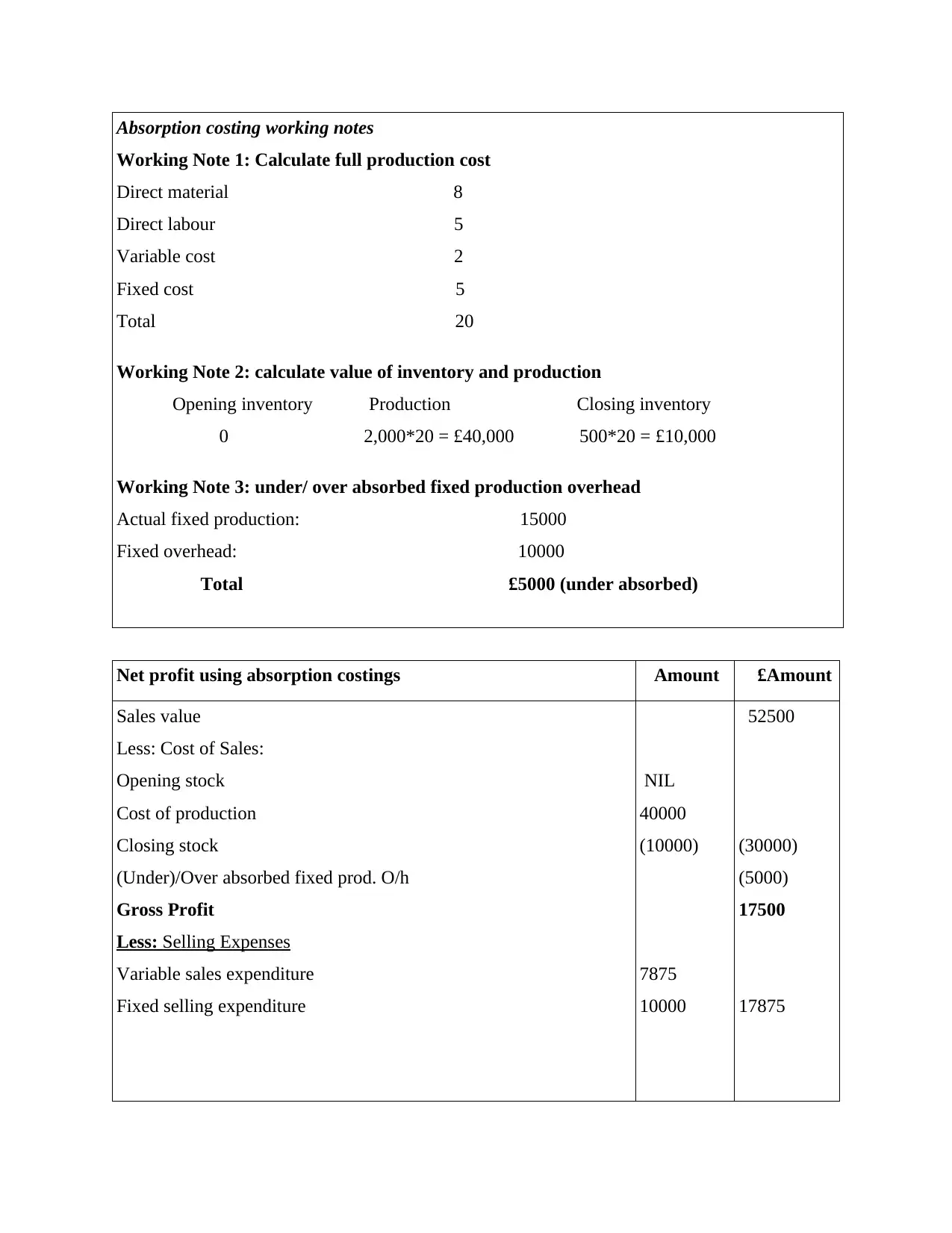
Absorption costing working notes
Working Note 1: Calculate full production cost
Direct material £8
Direct labour £5
Variable cost £2
Fixed cost £5
Total £20
Working Note 2: calculate value of inventory and production
Opening inventory Production Closing inventory
0 2,000*20 = £40,000 500*20 = £10,000
Working Note 3: under/ over absorbed fixed production overhead
Actual fixed production: £15000
Fixed overhead: £10000
Total £5000 (under absorbed)
Net profit using absorption costings £Amount £Amount
Sales value
Less: Cost of Sales:
Opening stock
Cost of production
Closing stock
(Under)/Over absorbed fixed prod. O/h
Gross Profit
Less: Selling Expenses
Variable sales expenditure
Fixed selling expenditure
NIL
40000
(10000)
7875
10000
52500
(30000)
(5000)
17500
17875
Working Note 1: Calculate full production cost
Direct material £8
Direct labour £5
Variable cost £2
Fixed cost £5
Total £20
Working Note 2: calculate value of inventory and production
Opening inventory Production Closing inventory
0 2,000*20 = £40,000 500*20 = £10,000
Working Note 3: under/ over absorbed fixed production overhead
Actual fixed production: £15000
Fixed overhead: £10000
Total £5000 (under absorbed)
Net profit using absorption costings £Amount £Amount
Sales value
Less: Cost of Sales:
Opening stock
Cost of production
Closing stock
(Under)/Over absorbed fixed prod. O/h
Gross Profit
Less: Selling Expenses
Variable sales expenditure
Fixed selling expenditure
NIL
40000
(10000)
7875
10000
52500
(30000)
(5000)
17500
17875
⊘ This is a preview!⊘
Do you want full access?
Subscribe today to unlock all pages.

Trusted by 1+ million students worldwide
1 out of 19
Related Documents
Your All-in-One AI-Powered Toolkit for Academic Success.
+13062052269
info@desklib.com
Available 24*7 on WhatsApp / Email
![[object Object]](/_next/static/media/star-bottom.7253800d.svg)
Unlock your academic potential
Copyright © 2020–2025 A2Z Services. All Rights Reserved. Developed and managed by ZUCOL.




